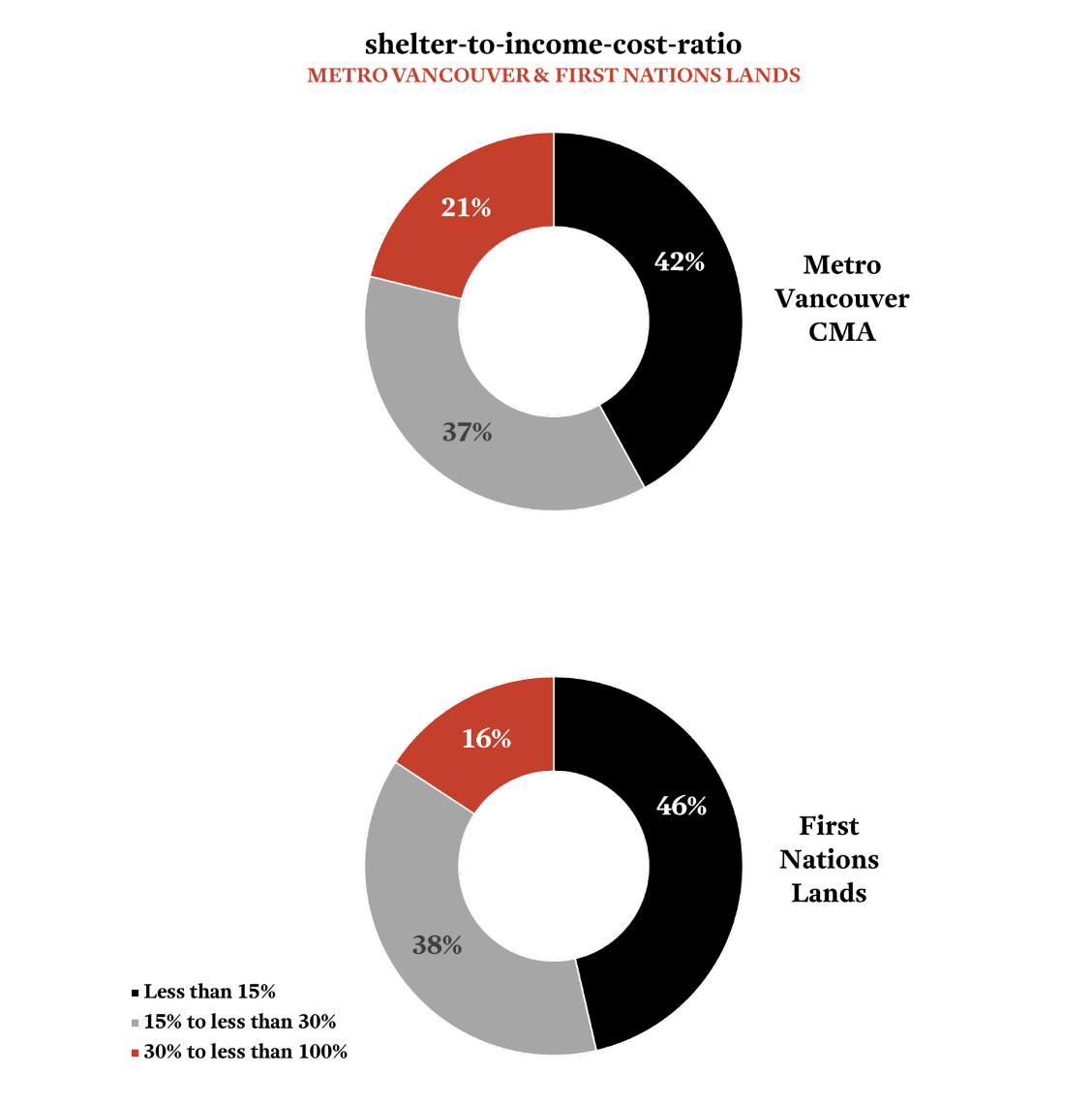What You need to Know About the 2021 Census Release on Indigenous People & Housing on First Nation Lands
Oct 20, 2022
Written by
Ryan BerlinSHARE THIS
- As of 2021, there were 1.8 million Indigenous people living in Canada, up 9.4% from 2016 (compared to 5.3% growth in the non-Indigenous population)
- Metro Vancouver’s Indigenous population is much younger (29% under the age of 20) than its non-Indegenous counterpart (19%)
- In looking at leasehold owners on First Nation lands in Metro Vancouver, only 16% spend more than 30% of their income on housing, compared to 21% for owners in Metro Vancouver as a whole
A YOUNG POPULATION
Metro Vancouver’s Indigenous population is younger than its non-Indigenous counterpart, with almost 1 out of every 3 Indigenous persons (29%) being under the age of 20, versus 1 out of 5 non-Indigenous persons (19%) who is. Interestingly, the share of residents of working-age (25-64 year olds) here in Metro Vancouver are similar within each of the Indigenous and non-Indigenous populations (at 63% and 64%, respectively). Meanwhile, the non-Indigenous population in Metro Vancouver has almost twice the share of people aged 65-plus than does the Indigenous group, at 17% versus 9%, respectively.AN AFFORDABLE HOUSING OPTION
One (of many) elements included in the latest Census release that caught our attention is related to leasehold property ownership. Here in Metro Vancouver (and throughout BC), First Nations communities have increasingly been developing land for much-needed housing, with the tenure of the new housing often taking the form of leasehold ownership whereby buyers purchase the home (but not the land) as part of a very long-term land lease with the local First Nation; such buyers can include both members of First Nations and non-members. Because the buyers of such leasehold properties own the physical home but not the underlying land, leasehold properties are typically priced lower than their freehold counterparts (all else being equal) and thereby represent a more affordable owned housing option. The affordability feature of leasehold properties can be demonstrated through consideration of the “shelter-cost-to-income ratio” metric from the Census, which refers to the proportion of total gross household income that is spent on shelter costs (including mortgage payments, heating, and maintenance, among other things). On First Nation lands within Metro Vancouver, 46% of owners spend less than 15% of their income on shelter costs, compared to 42% of owners in the whole of Metro Vancouver (note that First Nations homeowners account for 0.4% of all owner-occupied households in the region). While spending more than 30% of one’s income on shelter costs is considered unaffordable, it is notable that only 16% of owners on First Nation lands in Metro Vancouver spend above this threshold, compared to 21% in Metro Vancouver as a whole. Clearly, new housing development on First Nations land is not just adding much-needed supply to our under-built housing stock, but it is also providing affordable options for buyers that might not be available elsewhere in the market.Our rennie intelligence team comprises our in-house demographer, senior economist, and market analysts. Together, they empower individuals, organizations, and institutions with data-driven market insight and analysis. Experts in urban land economics, community planning, shifting demographics, and real estate trends, their strategic research supports a comprehensive advisory service offering and forms the basis of frequent reports and public presentations. Their thoughtful and objective approach truly embodies the core values of rennie.
On First Nation lands within Metro Vancouver, 46% of owners spend less than 15% of their income on shelter costs, compared to 42% of owners in the whole of Metro Vancouver (note that First Nations homeowners account for 0.4% of all owner-occupied households in the region). While spending more than 30% of one’s income on shelter costs is considered unaffordable, it is notable that only 16% of owners on First Nation lands in Metro Vancouver spend above this threshold, compared to 21% in Metro Vancouver as a whole. Clearly, new housing development on First Nations land is not just adding much-needed supply to our under-built housing stock, but it is also providing affordable options for buyers that might not be available elsewhere in the market.Our rennie intelligence team comprises our in-house demographer, senior economist, and market analysts. Together, they empower individuals, organizations, and institutions with data-driven market insight and analysis. Experts in urban land economics, community planning, shifting demographics, and real estate trends, their strategic research supports a comprehensive advisory service offering and forms the basis of frequent reports and public presentations. Their thoughtful and objective approach truly embodies the core values of rennie.Written by
Ryan Berlin
SHARE THIS
Related
wonky math: the student visa cap & what it means for metro vancouver
To those following—or immersed in—conversations about population growth in Canada, the role of international migration in that growth, and the generally insufficient supply of housing in most metro regions across the country, the recent student visa cap announcement by the federal government didn’t come as much of a surprise.
Jan 2024
Article
6 min read
from evergreen to ever-red?
Do recent net outflows of migrants from Washington portend a longer-term trend?
Jan 2024
Article
5 min Read